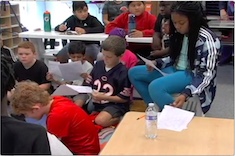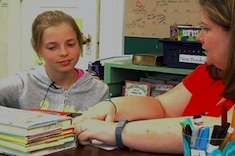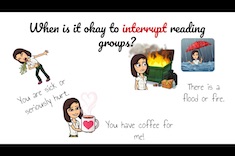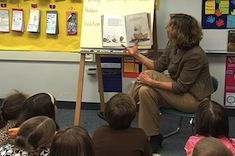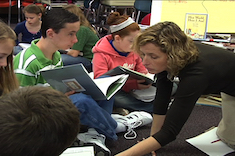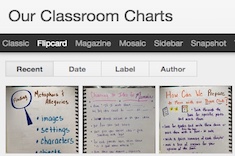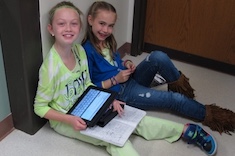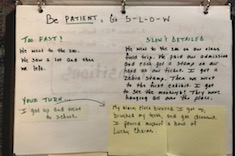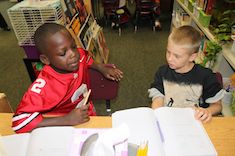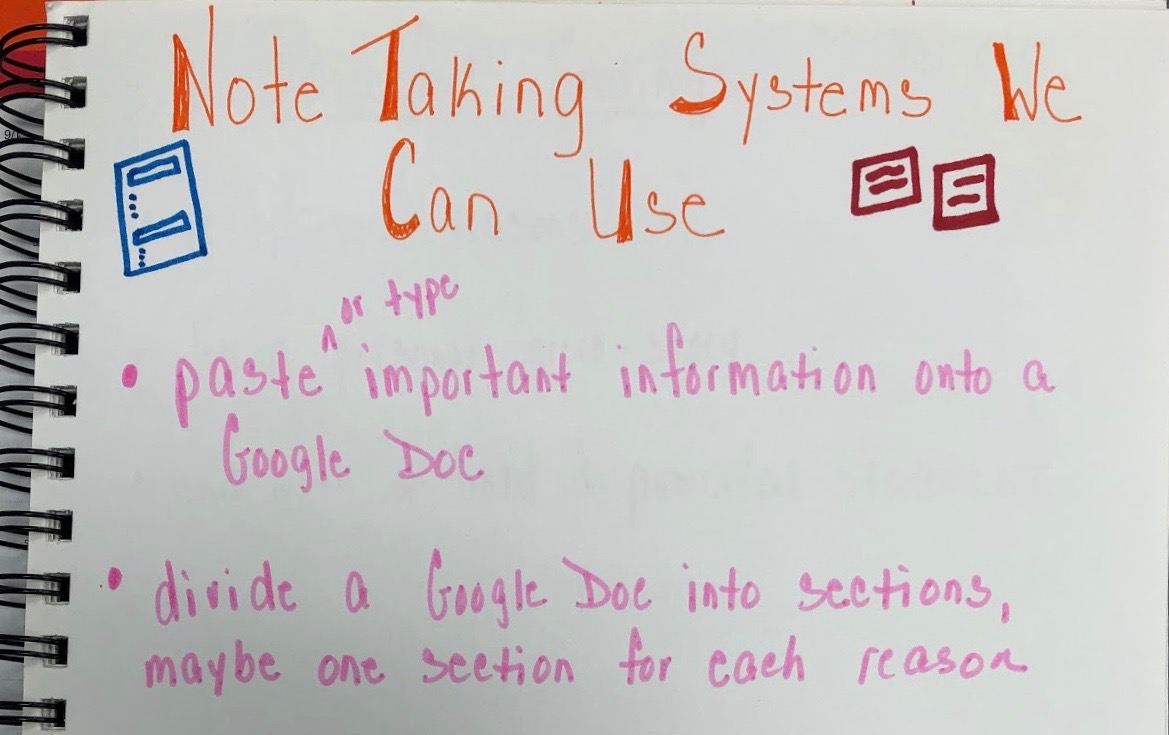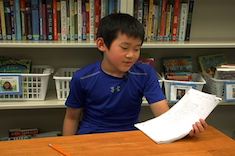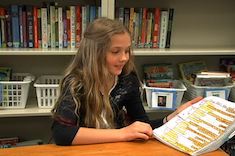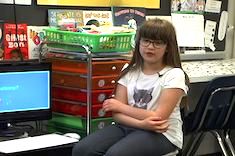5th
Latest Content
Writing Share Circle in Fifth Grade
Here are some excerpts from a writing share circle in Dana Murphy’s fifth-grade classroom. Each student shares a one- to two-sentence excerpt from the writing they completed during the day’s workshop.
Circle Share
Sometimes “winging it” because we don’t have plans can lead to the most profound learning. Dana Murphy dreams up a quick circle share, and what follows is magic.
Creating a Realistic Fiction Stack
Katherine Sokolowski confers with a fifth grader who is looking for book recommendations. She creates a stack of realistic fiction books based on the student’s interests.
Minimizing Interruptions During Workshops
Dana Murphy explains why a system for minimizing interruptions is essential in her fifth-grade classroom, and how she keeps the process of creating and using it as simple as possible.
The Power of Video Replay
Heather Fisher explains how viewing excerpts from the same video multiple times can help students in book clubs hone their conversation and reflection skills.
Book Club Tools
Tammy Mulligan shares the importance of giving students choice and agency with book club tools to improve engagement and the quality of the conversations.
Moving from Interactive Read Alouds to Book Clubs
Tammy Mulligan shares how teachers can move seamlessly from thoughtful conversations during whole-class read alouds to lively book clubs.
Do Students Need to Love the Books We Read Aloud?
Franki Sibberson asks a critical question: Do students need to love the read alouds we share in classrooms? She works to move students beyond shallow like/don’t like responses to books.
Grand Conversations and Read Aloud
Are your conversations during read aloud stilted or shallow? Tammy Mulligan recommends weekly “grand conversations” to spark more thoughtful talk. She provides the tools you need to get started in your classroom.
Interactive Read Aloud and the Whole-Class Notebook
Tammy Mulligan enhances the quality of the class read aloud and student discussions with the use of a whole-class response notebook.
A New System for Anchor Charts
Dana Murphy develops a love-hate relationship with the faded anchor charts peeling away from her classroom walls. She finds a move to anchor charts in a sketchbook and a website for chart images improves the quality of her charts and their usefulness.
Young Learners and Self-Talk
Do you have young readers and writers in your class who constantly talk to themselves? Stella Villalba helps a teacher decode the value of this self-talk for first grader Kayla, using it as a springboard for more learning.
Status of the Class: Reflecting on Reading Communities
Franki Sibberson uses status of the class each day as a window into her fledgling reading community.
A Better Status of the Class
Dana Murphy finds that adding numbers of pages to her status-of-the-class list for reading makes all the difference in assessing students’ growth and needs as readers.
Setting and Using Classroom Norms
Class promises, rules, and norms—most teachers set them at the start of the year. But how can we make sure students live them? Dana Murphy shares some tips from her fifth-grade classroom.
Read-Aloud Annotations: Google Slides
In this video series, Franki Sibberson’s fifth graders share their strategies for annotating the class read aloud. In this installment, Antonio shares his Google Slides.
Guided Reading for Proficient Readers?
Shari Frost is surprised to see guided reading used for proficient fifth-grade readers. She considers some strategic alternatives.
Using a Strategy Notebook in Small-Group Instruction
So many needs for groups, and so little time. Dana Murphy finds that a strategy notebook is invaluable as a teaching aid in her fifth-grade small groups.
Read-Aloud Annotations: Google Docs for Questions
In this video series, Franki Sibberson’s fifth graders share their strategies for annotating the class read-aloud. In this installment, Lauren uses Google Docs to record questions to explore as she listens.
Read-Aloud Annotations: Expectation and Reality
In this video series, Franki Sibberson’s fifth graders share their strategies for annotating the class read-aloud. In this installment, Lizzie uses her notebook to focus on expectations and reality for characters, especially when it comes to stereotypes.
Talking Through Characters
Melanie Meehan shares activities that help students talk about their characters before writing about them in a realistic fiction unit.
Read Aloud Annotations: Using Google Slides to Focus
In this video series, Franki Sibberson’s fifth graders share their strategies for annotating the class read-aloud, In this installment, Reagan uses Google Slides to focus her thoughts and analyze different characters.
Student-Centered Notes
Dana Murphy discovers that what works for one student doesn’t work for another when it comes to note-taking. She provides options and then hosts a gallery walk so everyone can discover what works best for them.
Read-Aloud Annotations: Thoughts to Themes
In this video series, Franki Sibberson’s fifth graders share their strategies for annotating the class read-aloud. In this installment, Stone uses Google Slides to record thoughts and tease out themes.
Read Aloud Annotations: Predictions
In this video series, Franki Sibberson’s fifth graders share their strategies for annotating the class read aloud. In this installment, Sharvari uses Google Slides with text boxes to record predictions and thinking.
Read Aloud Annotations: Characters and Intentions
In this video series, Franki Sibberson’s fifth graders share their strategies for annotating the class read aloud The Girl Who Drank the Moon. In this installment, Ben creates a graph in his notebook to record characters and intentions that are emerging in the story.
Alternatives to Graphic Organizers
Dana Murphy is dismayed by the ways graphic organizers can sometimes limit student creativity. She uses writing notebooks and a few other strategies to begin to wean her fourth graders from depending too much on organizers.
Read-Aloud Annotations: Notebook Predictions
In this video series, Franki Sibberson’s fifth graders share their strategies for annotating the class read aloud, The Girl Who Drank the Moon. Students have their choice of using notebooks or tech devices, and can pick any strategy that helps them make sense of the story. In this installment, Hannah shares her notebook where she highlights the setting and characters, as well as makes predictions.
Student-Led Minilession: Planning and Organizing Nonfiction Writing
Katie presents a student-led minilesson in Franki Sibberson’s fifth-grade class on organizing and planning nonfiction writing.
Forming Groups Using a Planner
Dana Murphy explains how her small-group planner is an essential tool for organizing groups in her fourth-grade classroom.
Browse Content By
Type
Category
- Assessment Tools
- Big Fresh Archives
- Booklists
- Choice Numeracy
- Classroom Design
- Common Core
- Community Building
- Conferring
- Content Literacy
- Digital Literacy
- English Language Learners
- Equity
- Family Relations
- Free Samples
- Guiding Groups
- Leadership
- Literacy Coaches
- Mentor Texts
- Minilessons
- New Teacher Mentors
- Podcasts
- Poetry
- Quote Collections
- Reading Strategies
- Self Care
- Struggling and Striving Learners
- Talking and Listening
- Teacher Study Groups
- Teaching Reading
- Teaching Writing
- Word Study and Vocabulary
Author
- Melissa Quimby
- Nawal Qarooni
- Gwen Blumberg
- Julie Cox
- The Lead Learners
- Hannah Tills
- Josie Stewart
- Ruth Metcalfe
- Mallory Messenger
- Becca Burk
- Jodie Bailey
- Vivian Chen
- Mary Brower
- Tiffany Abbott Fuller
- Stephanie Affinito
- Ruth Ayres
- Leigh Anne Eck
- Heather Fisher
- Shari Frost
- Julie Johnson
- Suzy Kaback
- Gigi McAllister
- Shirl McPhillips
- Melanie Meehan
- Cathy Mere
- Debbie Miller
- Tara Barnett and Kate Mills
- Tammy Mulligan
- Dana Murphy
- Bitsy Parks
- David Pittman
- Brenda Power
- Heather Rader
- Matt Renwick
- Mandy Robek
- Christy Rush-Levine
- Gretchen Schroeder
- Jen Schwanke
- Brian Sepe
- Katherine Sokolowski
- Stella Villalba
- Jennifer Vincent
Grade Level
Choice Literacy Membership
Articles
Get full access to all Choice Literacy article content
Videos
Get full access to all Choice Literacy video content
Courses
Access Choice Literacy course curriculum and training

